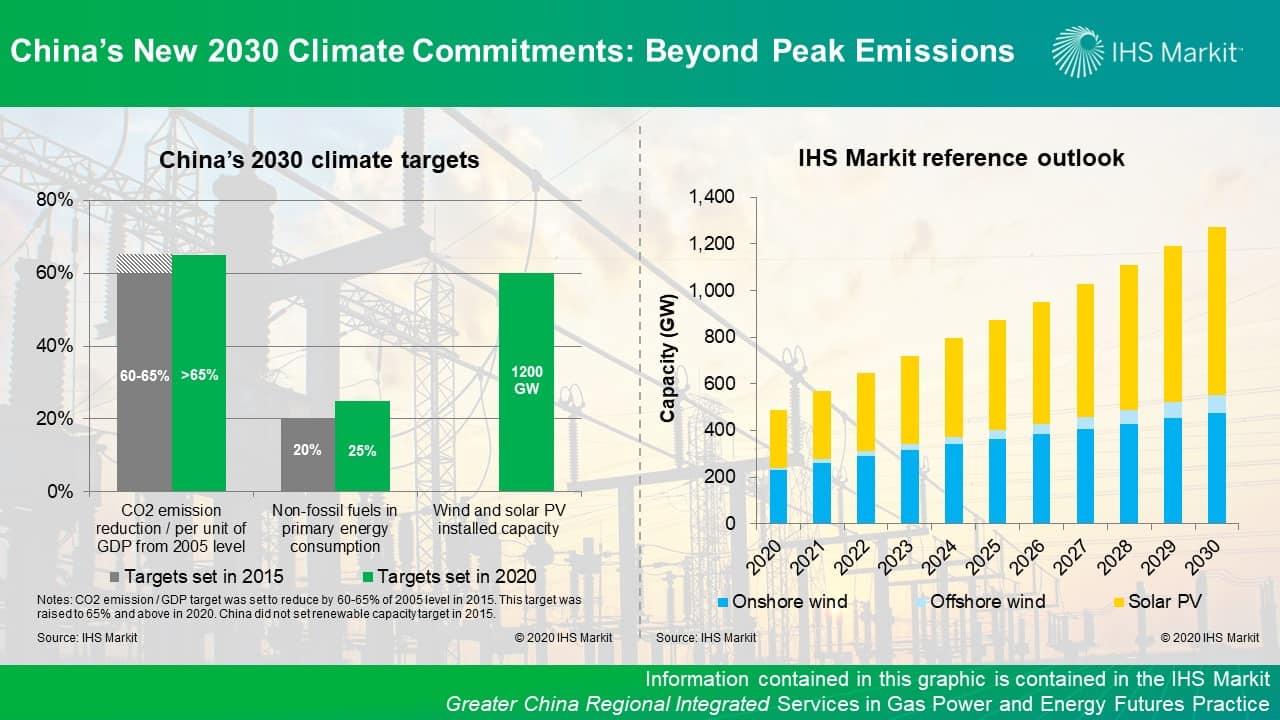China's new 2030 climate commitments: Beyond peak emissions
On 12 December 2020, Chinese President Xi Jinping announced
updated 2030 carbon targets at the Climate Ambition Summit,
representing a part of China's new Intended Nationally Determined
Contributions (INDC).
- Reduce carbon emissions per unit of GDP by over 65% from the 2005
level;
- Increase non-fossil fuels in primary energy consumption to around
25%;
- Increase the forest stock volume by 6 billion cubic meters from
the 2005 level;
- Increase wind and solar power generation capacity to at least
1,200 GW.
Under the Paris agreement, countries are expected to make their climate commitments more aggressive overtime during subsequent years. For China, most of the updated 2030 targets represent an incremental tightening from those stated five years ago in Paris, especially compared with Xi's 2060 carbon neutrality pledge made in September.
Carbon intensity
China started to include carbon emissions per unit of GDP, or
carbon emission intensity targets, in five-year plans (FYPs) from
2011, after joining the Copenhagen Climate Change Agreement at the
end of 2009. During the past decade, China has reduced carbon
intensity by more than 35% and met its 2020 target of 40-45%
reduction from the 2005 level ahead of time.
The new 2030 commitment is nearly a reiteration from the target set
in 2015, except that the previous upper bound of 65% becomes a
minimum requirement in the new target. Going forward, we believe
the economic restructuring—from heavy industry to light
industry and services—as well as energy efficiency gains and
energy mix change towards low carbon technologies will continue
underpinning the carbon intensity reduction.
In addition, carbon price could potentially become a powerful
policy tool during the next decade to support climate efforts. The
Ministry of Ecology and Environment recently issued policies on the
regulatory framework for national emission trading scheme (ETS),
indicating good progress in the national carbon market buildup
after nearly 3 years of stagnation.
Share of non-fossil energy
In contrary to the carbon intensity goal, the new 2030 target of
non-fossil share in primary energy consumption exhibited a bigger
change, from the previous target of 20% to now 25%.
During the past decade, non-fossil fuel share increased by 3-4%
every five years, now standing at roughly 15%. This means that
China needs to increase non-fossil share by about 10% over the next
decade.
This represents a faster pace than in the previous decade, but not
drastically different. As a matter of fact, if China maintains this
same pace until 2060, non-fossil fuel share will only reach 55%,
far from what carbon neutrality requires.
Renewable capacity in electric power
One element that stood out is the fact that for the first time
specific renewables installed capacity target is included in the
climate goals. But the wind and the solar target is not overly
aggressive, either. In the latest IHS Markit outlook (issued before
2060 carbon neutrality pledge was announced), China is expected to
add more than 70 GW wind and solar capacity each year during the
next decade and build up a renewables fleet of over 1,200 GW by
2030, in line with the new NDC.
The increasing penetration of renewables will be accompanied by a
reduction of coal-fired power capacity, as well as the growth of
hydro, nuclear and battery storage to maintain the capacity
adequacy and reliability of power supply.
Overall, the new 2030 NDCs reaffirmed China's commitment to the Paris climate agreement. In fact, they go beyond the goal of peaking carbon emission before 2030 and signal a progressively accelerated transformation pace urged by 2060 carbon-neutral goal. Short-to-medium term policies will remain focused on aligning efforts and gathering momentum before China accelerates the energy transition more aggressively towards a net-zero carbon future in the long run.

Learn more about our coverage of the Greater China energy market through our Asia Pacific Regional Integrated service.
Bing Han is a senior research analyst on the Gas, Power and Energy Futures team at IHS Markit.
Lara Dong is a senior director on the Gas, Power, and Energy Futures team at IHS Markit.
Posted on 15 December 2020

